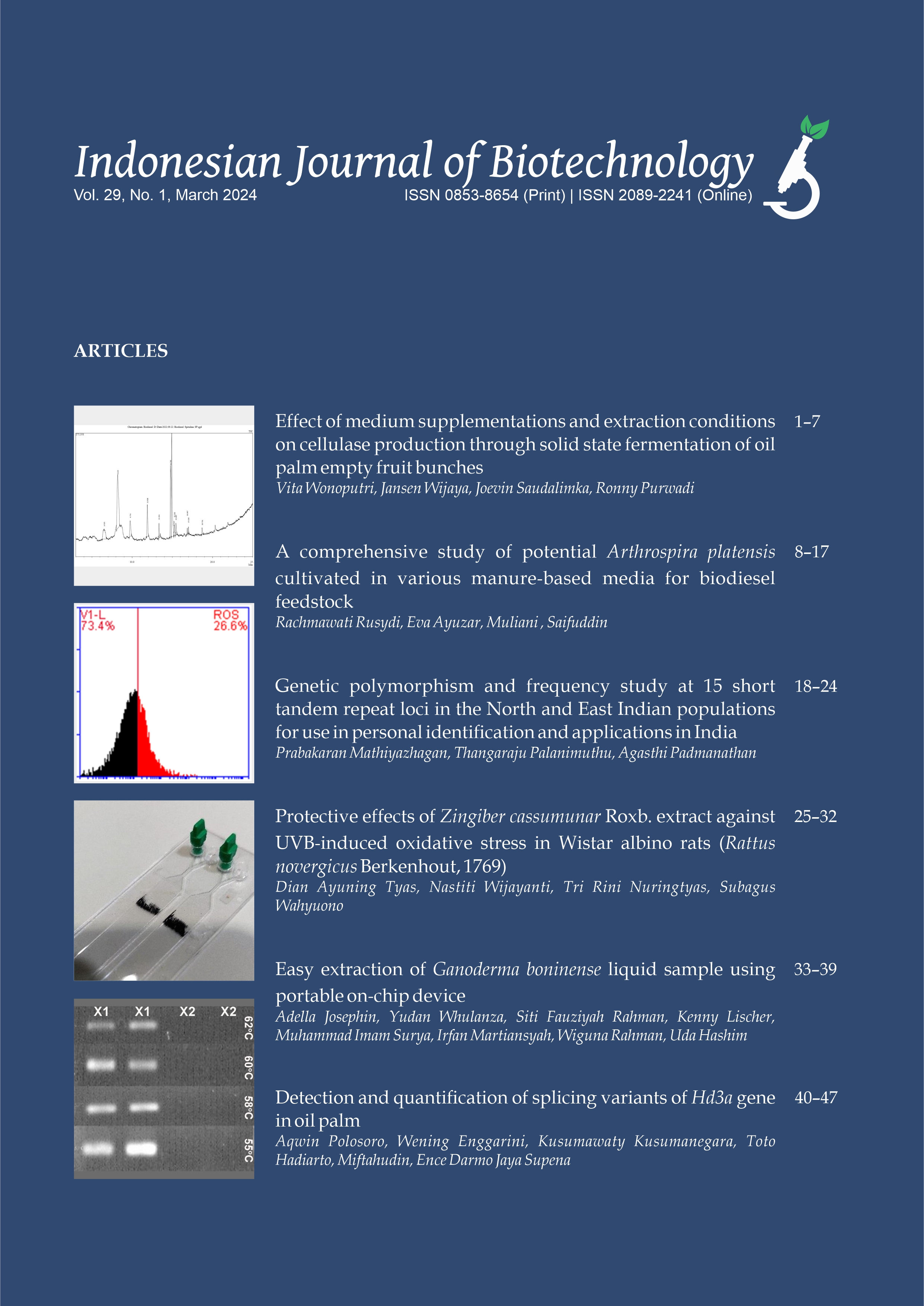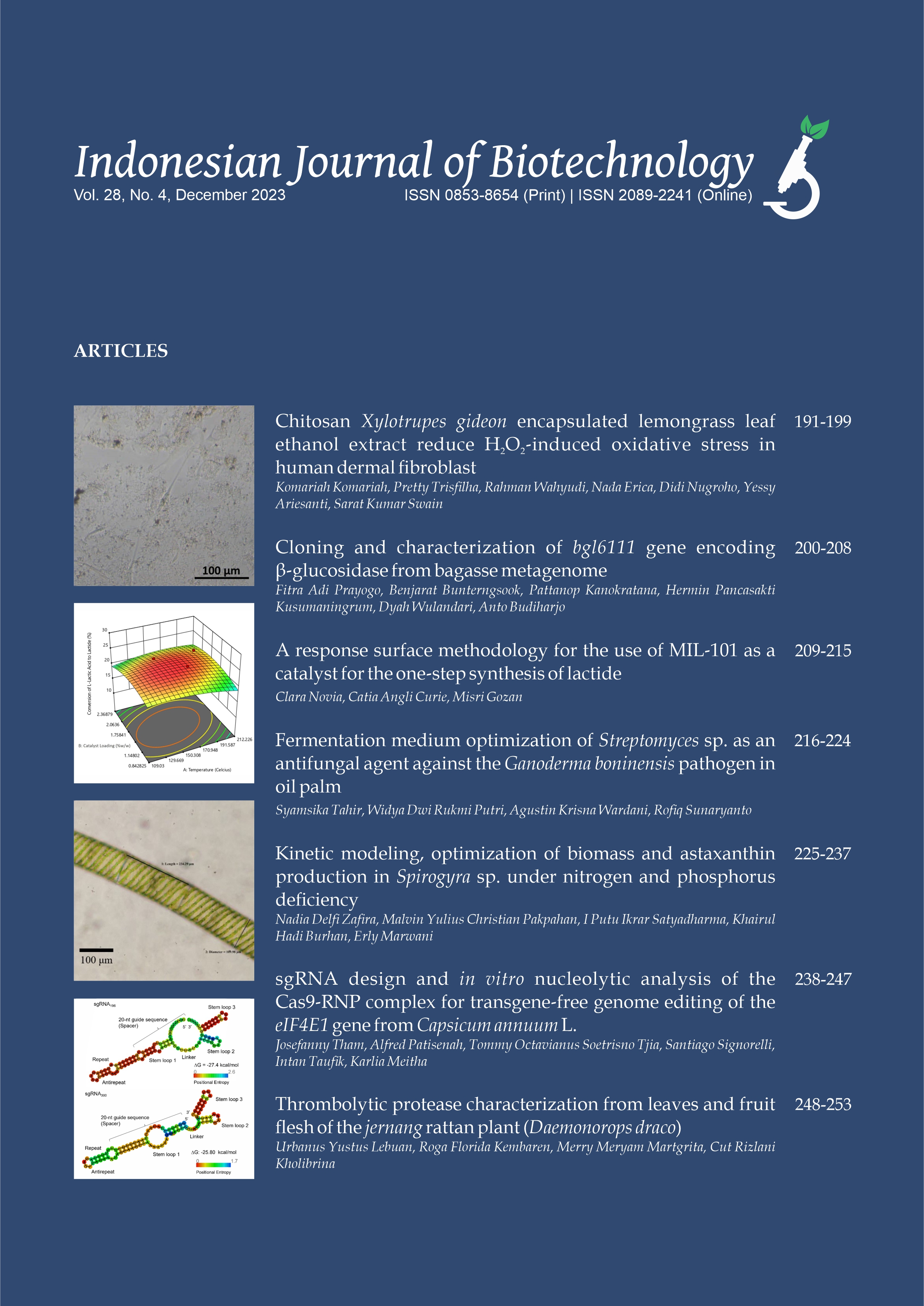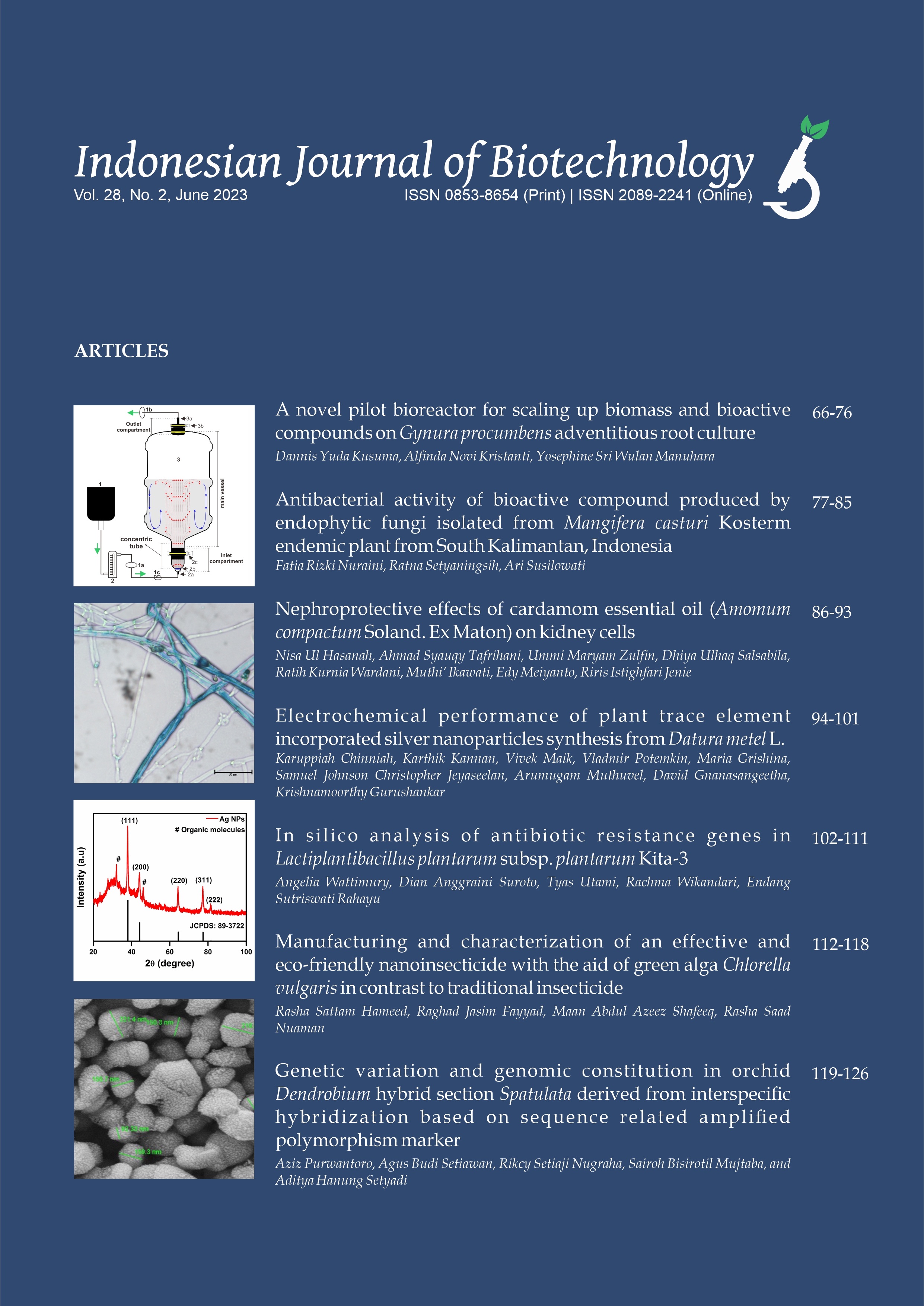MicroRNA-21 as a biomarker for ovarian cancer detection
Aprilia Indra Kartika(1*), Siti Nur Chasanah(2), Akbar Satria Fitriawan(3), Dewi Sahfitri Tanjung(4), Addin Trirahmanto(5), Heru Pradjatmo(6), Teguh Aryandono(7), Sofia Mubarika Haryana(8)
(1) Faculty of Nursing and Health Sciences, Universitas Muhammadiyah Semarang, Semarang 50273
(2) Biomedical Sciences Graduate Program, Faculty of Medicine, Universitas Gadjah Mada, Jalan Farmako, Sekip Utara, Yogyakarta 55281
(3) Biomedical Sciences Graduate Program, Faculty of Medicine, Universitas Gadjah Mada, Jalan Farmako, Sekip Utara, Yogyakarta 55281
(4) Biotechnology Graduate Program, Graduate School of Universitas Gadjah Mada, Jalan Teknika Utara, Barek, Yogyakarta 55281
(5) Department of Obstetrics and Gynecology, Faculty of Medicine, Universitas Gadjah Mada, Jalan Farmako, Sekip Utara, Yogyakarta 55281
(6) Department of Obstetrics and Gynecology, Faculty of Medicine, Universitas Gadjah Mada, Jalan Farmako, Sekip Utara, Yogyakarta 55281
(7) Department of Surgery, Faculty of Medicine, Universitas Gadjah Mada, Jalan Farmako, Sekip Utara, Yogyakarta 55281
(8) Department of Histology and Cellular Biology, Faculty of Medicine, Universitas Gadjah Mada, Jalan Farmako, Sekip Utara, Yogyakarta 55281
(*) Corresponding Author
Abstract
Keywords
Full Text:
Kartika et al.References
Bast RC, Hennessy B, Mills GB. 2009. The biology of ovarian cancer: new opportunities for translation. Nature Reviews Cancer 9:415–428. doi:10.1038/nrc2644.
Bhatt AN, Mathur R, Farooque A, Verma A, Dwarakanath BS. 2010. Cancer biomarkers - current perspectives. The Indian Journal of Medical Research 132:129–149.
Cannistra SA. 2004. Cancer of the ovary. New England Journal of Medicine351:2519–2529. doi:10.1056/NEJMra041842.
Chao A, Lai C-H, Chen H-C, Lin C-Y, Tsai C-L, Tang Y-H, Huang H-J, Lin C-T, Chen M-Y, Huang K-G, et al. 2014. Serum microRNAs in clear cell carcinoma of the ovary. Taiwanese Journal of Obstetrics and Gynecology 53:536–541. doi:10.1016/j.tjog.2014.07.005.
Chen Y, Zhang L, Hao Q. 2013. Candidate microRNA biomarkers in human epithelial ovarian cancer: systematic review profiling studies and experimental validation. Cancer Cell International 13:86. doi:10.1186/1475-2867-13-86.
Cho KR, Shih I-M. 2009. Ovarian Cancer. Annual review of pathology: mechanisms of disease 4:287–313. doi:10.1146/annurev.pathol.4.110807.092246.
Coticchia CM, Yang J, Moses MA. 2008. Ovarian cancer biomarkers: current options and future promise. Journal of the National Comprehensive Cancer Network 6:795–802.
Davidson-Moncada J, Papavasiliou FN, Tam W. 2010. MicroRNAs of the immune system: roles in inflammation and cancer. Annals of the New York Academy of Sciences. 1183:183–194. doi:10.1111/j.1749-6632.2009.05121.x.
Iorio MV, Visone R, Di Leva G, Donati V, Petrocca F, Casalini P, Taccioli C, Volinia S, Liu C-G, Alder H, et al. 2007. MicroRNA signatures in human ovarian cancer. Cancer Research 67:8699–8707. doi:10.1158/0008-5472.CAN-07-1936.
Koutsaki M, Spandidos DA, Zaravinos A. 2014. Epithelial–mesenchymal transition-associated miRNAs in ovarian carcinoma, with highlight on the miR-200 family: prognostic value and prospective role in ovarian cancer therapeutics. Cancer Letters 351:173–181. doi:10.1016/j.canlet.2014.05.022.
Kuehbacher A, Urbich C, Dimmeler S. 2008. Targeting microRNA expression to regulate angiogenesis. Trends in Pharmacological Sciences 29:12–15. doi:10.1016/j.tips.2007.10.014.
Liu Z-Y, Zhang G-L, Wang M-M, Xiong Y-N, Cui H-Q. 2011. MicroRNA-663 targets TGFB1 and regulates lung cancer proliferation. Asian Pacific Journal of Cancer Prevention 12:2819–2823.
Mezzanzanica D, Bagnoli M, De Cecco L, Valeri B, Canevari S. 2010. Role of microRNAs in ovarian cancer pathogenesis and potential clinical implications. International Journal of Biochemistry & Cell Biology 42:1262–1272. doi:10.1016/j.biocel.2009.12.017.
Mo M-H, Chen L, Fu Y, Wang W, Fu SW. 2012. Cell-free Circulating miRNA biomarkers in cancer. Journal of Cancer 3:432–448. doi:10.7150/jca.4919.
Nam EJ, Yoon H, Kim SW, Kim H, Kim YT, Kim JH, Kim JW, Kim S. 2008. MicroRNA expression profiles in serous ovarian carcinoma. Clinical Cancer Research 14:2690–2695. doi:10.1158/1078-0432.CCR-07-1731.
Qu H, Xu W, Huang Y, Yang S. 2011. Circulating miRNAs: promising biomarkers of human cancer. Asian Pacific Journal of Cancer Prevention 12:1117–1125.
Rauh-Hain JA, Krivak TC, Del Carmen MG, Olawaiye AB. 2011. Ovarian cancer screening and early detection in the general population. Reviews in Obstetrics & Gynecology 4:15–21.
Resnick KE, Alder H, Hagan JP, Richardson DL, Croce CM, Cohn DE. 2009. The detection of differentially expressed microRNAs from the serum of ovarian cancer patients using a novel real-time PCR platform. Gynecologic Oncology 112:55–59. doi:10.1016/j.ygyno.2008.08.036.
Song T, Xia W, Shao N, Zhang X, Wang C, Wu Y, Dong J, Cai W, Li H. 2010. Differential miRNA expression profiles in bladder urothelial carcinomas. Asian Pacific Journal of Cancer Prevention 11:905–911.
Suryawanshi S, Vlad AM, Lin H-M, Mantia-Smaldone G, Laskey R, Lee M, Lin Y, Donnellan N, Klein-Patel M, Lee T, et al. 2013. Plasma MicroRNAs as novel biomarkers for endometriosis and endometriosis-associated ovarian cancer. Clinical Cancer Research 19:1213–1224. doi:10.1158/1078-0432.CCR-12-2726.
Taylor DD, Gercel-Taylor C. 2008. MicroRNA signatures of tumor-derived exosomes as diagnostic biomarkers of ovarian cancer. Gynecologic Oncology 110:13–21. doi:10.1016/j.ygyno.2008.04.033.
U.S. Preventive Services Task Force. 2004. Screening for ovarian cancer: recommendation statement. Annals of Family Medicine 2:260–262. doi:10.1370/afm.200.
Xu Y-Z, Xi Q-H, Ge W-L, Zhang X-Q. 2013. Identification of serum microRNA-21 as a biomarker for early detection and prognosis in human epithelial ovarian cancer. Asian Pacific Journal of Cancer Prevention 14:1057–1060.
Yang H, Kong W, He L, Zhao J-J, O’Donnell JD, Wang J, Wenham RM, Coppola D, Kruk PA, Nicosia SV, et al. 2008. MicroRNA expression profiling in human ovarian cancer: miR-214 induces cell survival and cisplatin resistance by targeting PTEN. Cancer Research 68:425–433. doi:10.1158/0008-5472.CAN-07-2488.
Zhou L, Zhao Y-P, Liu W-J, Dong J, Chen W-Y, Zhang T-P, Chen G, Shu H. 2012. Circulating microRNAs in cancer: diagnostic and prognostic significance. Expert Review of Anticancer Therapy. 12:283–288. doi:10.1586/era.11.197.
Article Metrics
Refbacks
- There are currently no refbacks.
Copyright (c) 2018 The Author(s)

This work is licensed under a Creative Commons Attribution-ShareAlike 4.0 International License.









